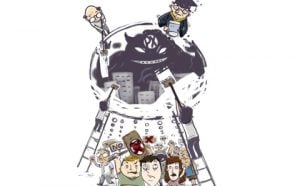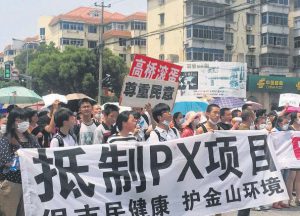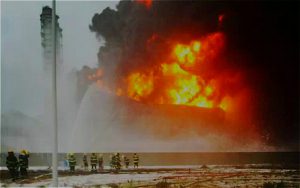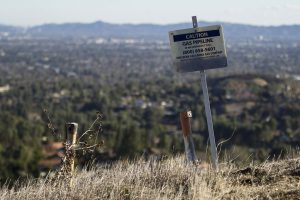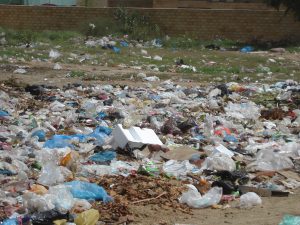Tu Chonghang is the winner of chinadialogue's China Environmental Press Awards 'Best Investigation' prize.
This story was originally published here by Beijing News on August 18, 2015.
The explosion occurred at the premises of Ruihai International Logistics in Tianjin’s Dongjiang port area at around 11pm on August 12, 2015, according to local police, after containers of hazardous materials caught fire.
A deputy general manager from Ruihai appeared on the scene the next day, clad in bandages covering wounds to his head and legs sustained in the explosion. He said the company’s general manager had also been injured and was in intensive care.
The company’s yard covered 46,000 square metres and contained: an office building, two warehouses, a transfer depot, an outside storage area, a block housing fire hydrants, an inspection gantry, and a waste water pool. The first explosion occurred inside one of the hazardous materials warehouses that contained hazardous materials; the second flattened both of them.
Yesterday, only the steel frame of the office building to the south of the yard remained standing. All that is left at the actual explosion site is a crater and a stretch of empty ground.
The deputy general manager, who did not give his name, said that the initial explosion was in a warehouse that stored chemicals, including: potassium nitrate, sodium nitrate and nitrate salts. According to an expert on the scene, all are highly explosive – heat or even a sharp impact can ignite them.
A company employee said that the depot, used as a temporary store for materials to be moved onwards after customs formalities, was also full of hazardous materials.
Many employees were injured in the explosion while others fled. Firefighters arriving at the scene were faced with stacks of burning containers and no idea what was inside.
Firefighters were faced with burning containers and no idea what was inside
The deputy general manager phoned an employee at the scene to establish what chemicals had been stored. The above employee reported that there were at least four different types: sodium hydroxide, hydrogen iodide, sodium hydrosulphide and sodium sulphide. Of these, sodium hydroxide cannot be disposed of by burial.
At about 2.45pm yesterday another explosion occurred as firefighters were spraying powder onto fires. A barrel lid flew into the air, followed by a plume of pungent yellow smoke. According to one employee, explosions were still being caused by the 21 tonnes of sodium hydrosulphide on site.
Prior to the second explosion, I saw firefighters spraying columns of water onto the site. Subsequently they stopped using water and attempted to smother the flames with sand, soil and concrete.
Homes in danger
Liang Hui, a nearby resident, thought the flash of light from the explosion was lightning. Thinking it might rain he went to close the window, only to be thrown to the floor by the blast, his face and torso peppered with broken glass.
Liang lives at Vanke Bay, just two kilometres from the Ruihai International site. There are 11 apartment complexes near here, all built and managed by well-known property developers. The closest include Vanke Haigang, less than a kilometre from the site of the blast, and Zhongjiao Qihang Jiayuan, about 800 metres away.
In the explosion 70% of the apartments at Wantong and Vanke Haigang were damaged, as glass doors and windows shattered. On the afternoon of August 13, glass was still falling as people walking below covering their heads for safety.
Do current regulations allow the construction of so many residential buildings in this area?
Our investigation found that rules for companies handling hazardous materials say that medium or large storage sites should be: at least one kilometre from public buildings; transportation infrastructure (roads, railways and shipping channels); and industrial or mining sites. At 46,226-square metres in size, Ruihai’s premises were classed as a large storage site.
A map of the local areas shows that the Donghai light rail station was less than one kilometre away. The station was destroyed in the blast, and the fencing lining the railway torn to shreds.
And residential buildings were less than a kilometre’s distance.
The storage facilities are understood to have been built later than the apartment complexes. It was under these circumstances that Tianjin Academy of Environmental Sciences (TAES) carried out an environmental impact assessment (EIA) for the company.
In May 2013 TAES reported on a second round of public consultation on the EIA process for the site, saying that 128 of 130 surveys issued had been returned. The results indicated that, “100% of the public say the site chosen is within the Beijiang harbour area and is suitable.”
An official with the Vanke Group said that the Vanke Haigang site had been purchased before 2010, with off-plan sales of apartments commencing in April 2010. Ruihai International Logistics was formed a year later, and in 2013 proposed building the storage site – but Vanke was never informed that this would mean storing hazardous materials.
“Nor did we or any of the apartment owners receive a survey from the Tianjin Academy of Environmental Sciences,” said the Vanke official.
Many apartment owners also said they had not been aware of any public consultation or received any survey.
Many apartment owners had not been aware of any public consultation or received any survey
Repeated attempts were made to phone TAES, but calls went unanswered. Ruihai chairman Li Liang’s phone remains turned off, and the company’s office phone cannot be reached.
Storage operations
A Ruihai employee said the company was one of only two companies in the bonded area of Dongjiang port, the other being Sinochem.
According to Ruihai’s website the company was founded in 2011 and acts a hub for the transfer and distribution of containers of hazardous materials. It is permitted to handle hazardous materials by both the Tianjin Maritime Administration and the Tianjin Transportation Commission.
Currently the company’s operations include the loading, unloading and transfer of containers of hazardous materials; handling customs declarations, distribution and storage. Its site is 46,226.8 square metres in total.
The company is understood to have carried out a number of emergency drills, and in August last year the public security authorities carried out a full inspection.
According to EIA documents from September 2014, changes made to the site were designed to allow annual throughput of 50,000 tonnes of hazardous materials, and 20,000 tonnes of normal goods. Hazardous materials included: calcium carbide, calcium-silicon alloys, sodium cyanide, toluene-2,4-disocyanate, sodium hydroxide, argon gas, methyl ethyl ketone, ethyl acetate, nitrocellulose, sulphur, potassium nitrate, sodium nitrate, formic acid, phosphoric acid, methane sulphonic acid and compressed natural gas. Other goods included PVC and rubber.
However, documents with the industrial and commercial authorities show that when founded the company was authorised to undertake, “storage business within the port area,” – with the storage of “hazardous materials” specifically excluded.
Last year the company’s scope of business was adjusted, with that exclusion removed and reference made to a list of permitted materials issued by the Tianjin Transportation Commission. That authorisation expired on October 16, 2014.
That list could not be located online, but is understood to cover hazardous materials. However, that was also only valid until October 16 last year.
Chemical cities
In 2011 He Shushan, then Party secretary of the Tianjin Development Zone and head of the zone’s management committee, said that “during the 12th Five Year Plan period Tianjin Nangang Industrial Zone will acquire a world-standard petrochemical investment.”
In May of that year the industrial zone approved 26 investment agreements falling within the Binhai New District, including a 13 million tonne Sino-Russian refinery and crude oil storage facilities for Sinopec and Petrochina.
According to local media: “By 2015 Tianjin will have storage for 35 million tonnes of crude oil; be refining 35 million tonnes of oil; and producing three million tonnes of ethylene and one million tonnes each of purified terephthalic acid, PVC, polyethylene and polypropylene.”
The Nangang Industrial Zone lies to the south-east of Binhai New District and covers 200 square kilometres, with 14.5 square kilometres an oil and gas field and building being planned for 147.5 square kilometres. Official materials show that the zone will focus mainly on the petrochemical industry and the manufacturing of equipment for the metallurgy industry and will undertake major projects to support the development of the port and create a comprehensive and integrated modern industrial port.”
One junior official with the Tianjin Development Zone commented that “I don’t know if all that actually happened, but this explosion certainly did.”
And this is just one more in a series of chemical industry incidents that Tianjin has seen.
On June 17, 2014, an unused tank at the Jinweihui site in Binhai exploded. The company produces petrol and solvents. One Internet user described the scene: “I saw huge flames, half the sky was red. At about 10pm there was a huge bang. Nobody lives near the explosion. Over ten fire engines arrived to put out the fire.”
At 4.20pm on July 12, 2014, there was an internal explosion in an oven at Tianjin Sinochem’s aromatic hydrocarbons workshop.
One planning expert from a Tianjin university said that residential buildings are built close to industrial zones such as this to provide homes for workers while the associated risks are ignored.
“It’s an outdated way of doing things,” he said.
Editor's Note: The explosion at a hazardous chemical warehouse in Tianjin was one of the biggest stories of 2015. Beijing News journalist Tu Zhonghang and his colleagues rushed to the scene and within a week had produced six investigative reports, revealing the types of chemicals involved, the cause of the explosion, who was responsible, related environmental impacts and safety assessments for the site and problems with local regulations – including a scoop on the risk of 700 tonnes of sodium cyanide leaking. Their reporting was both rapid and in-depth, setting a new example for the industry.

